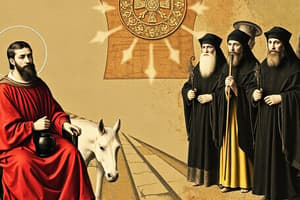Podcast
Questions and Answers
Who is Saint Benedict?
Who is Saint Benedict?
Benedict of Norcia
What did Saint Benedict do for three years in a mountain cave?
What did Saint Benedict do for three years in a mountain cave?
- Founded monasteries
- Wrote many texts
- Battled temptation (correct)
- Lived as a hermit
Saint Benedict died while leading a community of monks.
Saint Benedict died while leading a community of monks.
False (B)
Saint Benedict wrote a set of principles known as the _____ for his monks to live by.
Saint Benedict wrote a set of principles known as the _____ for his monks to live by.
When was the cornerstone of St. Bede's Hall laid?
When was the cornerstone of St. Bede's Hall laid?
What was the initial mission of the Spanish Benedictine monks in the Philippines?
What was the initial mission of the Spanish Benedictine monks in the Philippines?
The monks turned over their missions to the Jesuits in 1909.
The monks turned over their missions to the Jesuits in 1909.
What led to the monks relocating to Manila?
What led to the monks relocating to Manila?
Saint Benedict is the patron saint of _____ and the holy father of the Benedictine Order.
Saint Benedict is the patron saint of _____ and the holy father of the Benedictine Order.
How many monasteries did Saint Benedict found?
How many monasteries did Saint Benedict found?
Flashcards are hidden until you start studying
Study Notes
Saint Benedict and Monasticism
- Saint Benedict was born around 480 AD to Roman nobles in Norcia, Italy, during a period of societal upheaval following the fall of the Roman Empire.
- Disillusioned by the chaos, Benedict sought solitude and became a hermit, living in a cave near Subiaco, where he was sustained by the kindness of a monk named Romanus.
- After battling temptation for three years, Benedict became the leader of a monastic community, founding twelve monasteries, most notably Monte Cassino.
- He developed the Rule of Saint Benedict, a set of guidelines for communal living, emphasizing prayer and work, which has influenced Western monasticism for over 1,500 years.
- Saint Benedict is recognized as the father of Western monasticism and is the patron saint of Europe. His directives focused on glorifying God in all actions.
The Arrival of Benedictine Monks in the Philippines
- In 1895, thirteen Spanish Benedictine monks, led by Abbot Jose Deas y Villar from the Abbey of Montserrat in Spain, arrived in the Philippines intending to undertake mission work.
- Initial plans were to establish a mission in Surigao, Mindanao, but due to the Revolutionary outbreak in 1896, the monks relocated to Manila.
- The monks purchased a 7-hectare property on Mendiola Street for a new campus after realizing the need for a larger space.
- The cornerstone for St. Bede's Hall was laid on September 15, 1925, and the building was inaugurated on June 20, 1926, coinciding with the school's silver jubilee.
- The Abbey Church was consecrated on January 13, 1926, marking a significant milestone in the community's establishment.
Studying That Suits You
Use AI to generate personalized quizzes and flashcards to suit your learning preferences.





